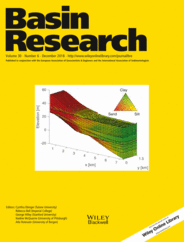
Full text loading...
 , Tore G. Klausen2, Jens Jahren1, Alvar Braathen1,3
, Tore G. Klausen2, Jens Jahren1, Alvar Braathen1,3 , Helge Hellevang1,3
, Helge Hellevang1,3
Temperature impacts the quality of reservoir and source rocks, thereby representing an important aspect of petroleum prospect assessments of any basin. This case study of the Triassic basin of Edgeøya, eastern Svalbard, reevaluate earlier burial estimates that were solely based on organic matter maturation data from organic rich shales. Here, we estimate temperatures using a multi‐method approach: Rock‐Eval pyrolysis parameters, fluid inclusions in diagenetic quartz, and inorganic diagenesis signatures of sandstones. Data were collected from organic rich shales of the Botneheia and Tschermakfjellet formations and coal bearing sandstones of the De Geerdalen Formation. Rock‐Eval pyrolysis data indicate that Botneheia and Tschermakfjellet formations experienced burial temperatures of about 124–138°C while the De Geerdalen Formation experienced temperatures ≥92°C. Homogenization temperatures of the De Geerdalen Formation sandstones give similar diagenetic temperatures, from 70 to 124°C, while the kaolinite to dickite transformation implies the temperatures >90°C. Furthermore, the absence of illite formation associated with kaolinite suggest that temperature have never exceed 130°C. Integrating various methods validate spatial variations in temperature proxies and constrain the thermal history of this basin. Cretaceous intrusions have locally affected the temperatures and have obscured regional subsidence and uplift trends. The effect of igneous intrusions on inorganic matter is very limited, but intensive on organic matter. These differences between organic and inorganic thermal indices help in distinguishing of magmatic from burial heating. This study has therefore relevance in deciphering the thermal history of sandstones experiencing magmatic activity coupled with multiple burial and uplift events.

Article metrics loading...

Full text loading...
References


Data & Media loading...

